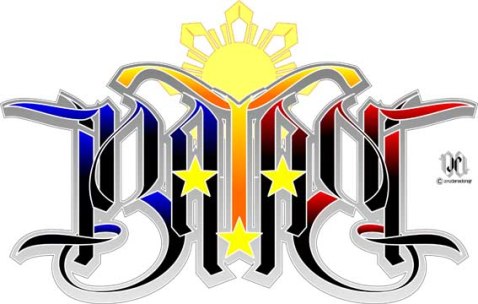In honor the ill-fated founder of the Katipunan, Andres Bonifacio, I present two ambigrams inspired by him.
The first is his title: Supremo (Supreme Leader), the next Maypagasa (literally means: there is hope, but i like the more romantic: hopeful) his pseudonym.

Andres Bonifacio founded the Kataastaasan Kagalanggalangang Katipunan ng mga Anak ng Bayan (High and Honorable Society of the Children of the Motherland) or KKK or simply the Katipunan. Initially a secret society, influenced by freemasonry, it was founded in 1892 in place of the defunct La Liga Filipina, which sought liberation of the (Philippine) islands from Spain. They mostly were lower to middle class in stature, unlike the La Liga with more affluent members. And although this title is largely attributed to him, Bonifacio became (third) Supremo of the Katipunan much later.

The elements of the first ambigram, Supremo, is based on the flags of the Katipunan. The first flag Bonifacio had his wife create, was a triangular red banner with three horizontal K’s on it, which was soon replaced by a rectangular one. Although his flag did not bear the Baybayin glyph for the phoneme “KA” (the glyph at the center of the “r”) some of the documents he signed as president of the society bore this glyph. It is said, however, that Bonifacio has a personal flag that is rectangular in shape with a white sun of undefined number of rays.
Then why use the glyph, at all?
Aside from my affection for this ancient writing and the shape of the “KA” glyph being perfect for an ambigram, it was predominantly used by the Magdalo faction of the Katipunan (led by Gen. Emilio Aguinaldo) on their banners, it seemed logical that while Bonifacio’s fate was sealed by those in this faction, putting the glyph with the design would serve as a reminder of how things turned out for him. Under the orders of (then recently elected) President Aguinaldo, Bonifacio was executed for treason May 10 1897. The story is very long and complicated to be told here.
(Side note: for more on Baybayin check out my previous post here.)

The second ambigram is Maypagasa. What a name for a man who died before seeing the realization of his hope for the motherland’s liberation. Had he known his fate, would he still have chosen that name?

Bonifacio is largely viewed as a bolo wielding barefooted take-no-prisoner fighter, which is a misconception altogether as he preferred his gun more than his bolo and apparently he dresses up based on his only extant photo available. Still, records show he was also an actor, a writer and a poet.
Here, I used a sheathed bolo with a writing plume as background images for the ambigram as counterpoint to our textbook taught image of Bonifacio we are accustomed to. Which may be interpreted in a variety of ways (the pen is mightier than the sword…; that there is another side to the image we have of Bonifacio… etc..). The ambigram design itself is represented in a script-like font in contrast to the sharper “Supremo” type style.
Initially I just did the two ambs but I though it’d be nice for one last homage. This one is not just for the Supremo but to the countless unsung heroes who bled and fought against invaders; who fought for liberation; who fought against oppression; and those who continue to fight for what is right. Also to those who struggle and fight against the tyranny of poverty; our school teachers, the Filipinos employed overseas, volunteer medical workers, volunteer educators, blood donors, the men and women with thankless jobs on the street, our parents. This is for you.

The word is Bayani, Filipino for hero. This reflective ambigram is designed with elements inspired by the Philippine flag.

Did you know that the Philippine flag is an ambigraph(?)? The flag in peacetime has the blue field on top (or to the left of the viewer when vertically presented) and with the red side on top (again, viewer’s left when vertical) if the country is at a state of war.
This week, we celebrate the birth of a hero. A patriot as seen in the pages of our history. Yet he is but one man, just like everyone else who lived, dreamed, and hoped. Here’s hoping we and our children do not have to endure what our forefathers bore in their lifetime and for courage to take up action protecting and defending what they gave their lives for.











